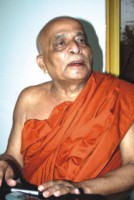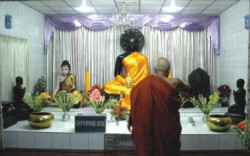|
Heritage
A Relic's Tale
Hana Shams Ahmed
 A serene setting inside the concrete heart of Dhaka. Workmen laying bricks to build a pathway from the entrance. Little boys wrapped in bright yellow cloth, their heads shaved and their feet bare. The silent water of the ponds against the backdrop of a one-storied brick building which had surely seen better days. The whiff of incense sticks together with the dying lights of the setting sun gives the surroundings an ethereal feel. This is the Buddhist monastery in Basabo where the air is still heavy from the happenings of the last few weeks. Two strands of very rare keshu dhatu (hair relic) said to have belonged to the great Gautam Buddha, which had been preserved in a monastery in Chittagong had been presented to the Sri Lankan official contingent that visited Bangladesh recently. A serene setting inside the concrete heart of Dhaka. Workmen laying bricks to build a pathway from the entrance. Little boys wrapped in bright yellow cloth, their heads shaved and their feet bare. The silent water of the ponds against the backdrop of a one-storied brick building which had surely seen better days. The whiff of incense sticks together with the dying lights of the setting sun gives the surroundings an ethereal feel. This is the Buddhist monastery in Basabo where the air is still heavy from the happenings of the last few weeks. Two strands of very rare keshu dhatu (hair relic) said to have belonged to the great Gautam Buddha, which had been preserved in a monastery in Chittagong had been presented to the Sri Lankan official contingent that visited Bangladesh recently.
Buddhism is one of the oldest religions in the world and as such relics of the Buddha, the founder of the religion, are the fewest in number. The teachings of the Buddha was passed down through word of mouth of the sanghya, a company of Buddhist monks, who memorised all his teachings until it was written down in the Pali language, 200 years after his death. Even the exact birth year of the Buddha, born as Prince Siddhartha Gautama, son of King Suddhodana, the chief of the Shakya nation (now a part of Nepal) and Queen Maha Maya, is disputed, although 563BC is generally accepted as his birth year.
 |
The Venerable Suddhanauda Mahathero, principal of the Basabo Bhuddhist Monastery is skeptical about the hair's authenticity. |
Historical records of his relics are very difficult to trace. According to them, after becoming enlightened at the age of 35, two merchants whom the Buddha met, named Tapussa and Bhallika became the first lay disciples. When they asked to have something of his the Buddha took some hair from his head and handed it to them. These hairs are believed to now be enshrined in the Shwe Dagon Temple in Rangoon, Burma. Buddha died at the age of 80 and people from all over came to pay their last respects for six days before his body was cremated. After the funeral there was confusion about the sharing of his ashes. Finally a Brahmin intervened and the ashes were divided into eight portions.
Venerable Suddhananda Mahathero, the principal of the Buddhist Monastery in Basabo and the President of Bangladesh Bouddha Kristi Prachar Sangha questions the origins of the hair, the last two of which are now in the Chittagong monastery. "According to our shastro (faith) when Gautam Buddha was enlightened 2551 years ago, the Tripitak mentions that two of his disciples, Tapussa and Bhallika received some hair from him which are now in Burma. We have never heard of it being anywhere else before," says Mahathero, "After Buddha's Parinibbana (his passing away), a powerful Brahmin collected the hair and divided it into 8 parts which were given to kings. Each of the kings put the ashes in giant pagodas that were built in memory of Lord Buddha in Thailand, Burma, Sri Lanka and India. There is no other history anywhere else about his hair."
According to the Bangladesh Buddhist Association Shakya Bhikkhu, a religious mendicant from Tibet, came to visit this region in 1930 carrying some hair relics of the Buddha. He went around several Buddhist temples and then finally came to the Chittagong Buddhist Temple and stayed there for some time. Impressed by the devotion of the then principal of the monastery Venerable Dharma Bangsha Mohasthabir, founder president of the Chittagong Buddhist Association, Shakya gave him the hair relics as a gift.
 "He was a very sagacious man," says Ajit Ranjan Barua, the president of Bangladesh Buddhist Association, "and the 'Aggya Mahapandit' title was given to him by the Burmese government. Dharma Bangsha handed over the relics to his disciple Venerable Dipankar Srigyan Mahasthabir and after that the monastery committee have been preserving them. "He was a very sagacious man," says Ajit Ranjan Barua, the president of Bangladesh Buddhist Association, "and the 'Aggya Mahapandit' title was given to him by the Burmese government. Dharma Bangsha handed over the relics to his disciple Venerable Dipankar Srigyan Mahasthabir and after that the monastery committee have been preserving them.
"At that time there was not much chance for publicity so it couldn't be let known," says Barua, "and during Buddha Purnima every year this hair is put on display.
It is not clear though how the hair came into the hands of this Tibetan monk. "The hairs that the two disciples had was taken to Burma, which is part of the Asian subcontinent," says Barua, "now perhaps those who brought it (the kesho dhatu) to Burma may have been handed down from one person to the other. This Bhikkhu may have acquired it from someone and then handed it over to us."
In 1985 relics of the Lord Buddha, comprising a fragment of a charred bone and ashes contained in a gilded stone casket, were found during excavations by the Archaeological Survey of India (ASI) at Lalitgiri in Jajpur district in 1985. According to another version Buddha's bones were discovered in a casket at Vaishaligarh, 35 kilometres from Patna, which does not corroborate with the Jajpur story. The story about the Chinese who claim to have a finger of Buddha does not corroborate with historical accounts of what bones remained after Buddha's body was burned which did not have a finger in the list.
"We are also displaying his asti dhatu bones," says Barua, "After his death, his bones were conserved in a lot of temples, but there is very little of his hair relic still left. We have given some of the keshu dhatu (hair relic) to Japan and Thailand before. In the same way that we are giving away a few at a time to these countries, the two disciples who acquired his hair may have given it away to others as well."
Because the Buddha's hairs are so sacred, Barua believes it deserves to be in a place where more people go to worship. "The more people that go to worship in a temple, the more beneficial it is for the temple. And besides, we do not have the financial capability to show the appreciation and esteem that such a relic deserves. They (the Sri Lankans) will preserve this relic with the proper religious respect that it deserves. In Japan they have a huge temple where the relics are preserved, as they do in Sri Lanka."
According to Barua the temple in Chittagong was established in 1889 and remains like that to this day. The last two remaining pieces of hair are displayed on special occasions at the Chittagong Buddhist Monastery.
Venerable Suddhananda Mahathero agrees that if it is indeed Buddha's hair then it should be given its due respect but says that it's authenticity should first be verified. "A committee should be formed with members from all over the subcontinent to verify the truth about this hair," says Mahathero, and if it is found to be so, it should be conserved properly."
"We do not interfere in the state's activities. We are not involved with political matters," says Mahathero, "but they are violating our rights by doing this. They have hurt our sentiments. Buddha's hair is a holy relic. Our demand is that if indeed his holy hair exists in our country it should be preserved with its due respect. We want to worship it."
Latifur Rahman, Director of the National Archives reflects his opinions. "This should have been preserved in our country with due respect," says Rahman, "the fact that such a thing existed was beyond my knowledge." Copyright
(R) thedailystar.net 2007 |
